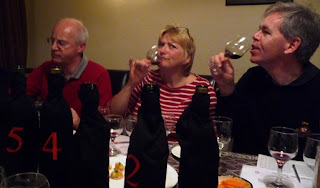The 12 month on-line course to help you learn about French wines - Top tips on how to get value when buying them - Reasonably priced up-to-date recommendations of what to buy and try in the UK - Bringing you the best of Tongham Village Hall wine tastings.
INTRODUCTION
This week we start a five week discovery of the lovely wines of South West France. Bordeaux is of course in South West France but it is always considered separately due to its size and importance. Bergerac, however, which is next door to Bordeaux, is always considered as part of Les Vins de Sud Ouest or wines of South West France. Over the years Bordeaux has considered adding Bergerac to its grouping but this has not happened yet. However, as we shall learn, the wines of Bergerac often bear a great similarity to those of Bordeaux in terms of taste and quality but often offer better value.
LOCALITY
The wines we are looking at this week are just to the East or South East of Bordeaux. Whereas, Bordeaux is in the Gironde, Bergerac is in the Dordogne, just next door. I have also included the wines of Buzet, Duras and Marmandais in this weeks selection and they are a little further south in the Lot et Garonne department.
This week’s wines are further inland from the Atlantic coast than those of Bordeaux and thus the climate is slightly less maritime. Many of the Bergerac wines are grown close to the Dordogne river, whereas those of Buzet lie on the Gironde.
VARIETALS
The grape varietals we find in the Bergerac and Buzet regions are similar to those found in Bordeaux. Thus we find plantings of Merlot, Cabernet Sauvignon and Cabernet Franc for the red wines and Semillon, Sauvignon Blanc and Muscadelle for the whites. Merlot tends to dominate the reds rather like it does in Right Bank Bordeaux wines.
THE WINES
The main various Bordeaux look-alike appellations of the South West region are:
Bergerac – A very large region producing red, white and rose wines.
Buzet – not to be confused with Bouzy which is a red wine from Champagne. Most of the wine is made by the local cooperative and is a Merlot dominated Bordeaux blend red wine that is improving.
Cotes de Duras – this region is just to the east of Bordeaux and south of Bergerac. It produces red, dry white and sweet white wines. You won’t see these often outside the region.
Cotes du Marmandais – This is just south of the Cotes de Duras. As well as the Bordeaux varietals they insist on some local varietals plus Gamay and Syrah making up at least 25% of the red wines. There is also a little white wine made.
Monbazillac – One of my favorite value sweet wines, it is the equivalent of a Sauternes. Similar wines are Sassignac and Rosette but these are harder to find outside the region.
Montravel – Mainly dry white wines using the using Bordeaux varieties.
Pecharmant – Another of my favourites, although I only really discovered it relatively recently. It is a lovely red wine, perhaps similar to a St Emillion. In France it can represent good value but you don’t see it often in the UK.
THE TASTE
Most of these wines taste similar to those of Bordeaux right bank and generic Bordeaux. Some producers go deliberately for a very Bordelais taste, some try to express the more local terroir and some are perhaps pleasantly rustic.
TOP TIPS
• Look out for Monbazillac as this is a great sweet white wine to be used in food pairings in a similar way to Sauternes.
• Look out for Pecharmant as this is a great value red wine in a similar style to right bank Bordeaux. Its a shame its so rarely seen in the UK.
HOMEWORK
For your homework this week you need to buy and try one of Bordeaux’s next door neighbours, sometime referred to as Bordeaux satellite wines. It may include one of the following wines:
Majestic -
Murets de Gouts 2008 Côtes du Marmandais – about £6
Waitrose -
Château Les Sablines 2006 Monbazillac– about £9 for 50cl
Waitrose -
Domaine des Eyssards 2009 Bergerac – about £7
Marks and Spencers –
Bergerac Dry White 2009 – about £6
However, your best bet this month is to head down to
Les Caves de Pyrene which is just off the Old Portsmouth Road outside of Guildford on the way to Godalming. They are both specialists in the wines of South West France and also promoters of real, natural wines; thus they make a pleasant change from the usual supermarket wines. As a wine lover you really need to try their wines. You will have to buy a mixed case of twelve and if you are following the course I would suggest you look for the following appellations to buy:
Week 14: Bergerac, Montbazillac, Buzet, Cotes de D uras, Marmandais.
Week 15: Cahors
Week 16: Gaillac, Marcillac, Fronton
Week 17: Jurancon or Pacherenc du Vic-Bilh
Week 18: Madiran, Irouleguy
With these 12 you will have a great mixed case lof South West wines. Which exact wines you choose will depend on your wallet.
FOOD PAIRINGS
For food pairings follow what you would do with a similar style Bordeaux.
Red – Roast dishes especially lamb, beef. Try also with pork and chicken.
Dry White – fish and seafood.
Sweet White – Foie Gras, non-chocolate desserts, some spicy food, Roquefort cheese.
COMING SOON
Next week we move on to the wines of Cahors which used to be famous for its very dark red wines. If you missed the early weeks of this course, it is not too late to catch up. Just click on the French Wine Course link at the top of this page.

























